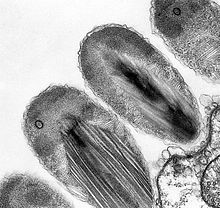
A spirochaete or spirochete is a member of the phylum Spirochaetota, which contains distinctive diderm (double-membrane) gram-negative bacteria, most of which have long, helically coiled cells. Spirochaetes are chemoheterotrophic in nature, with lengths between 3 and 500 μm and diameters around 0.09 to at least 3 μm.
The Aquificota phylum is a diverse collection of bacteria that live in harsh environmental settings. The name Aquificota was given to this phylum based on an early genus identified within this group, Aquifex, which is able to produce water by oxidizing hydrogen. They have been found in springs, pools, and oceans. They are autotrophs, and are the primary carbon fixers in their environments. These bacteria are Gram-negative, non-spore-forming rods. They are true bacteria as opposed to the other inhabitants of extreme environments, the Archaea.

The Chlamydiota are a bacterial phylum and class whose members are remarkably diverse, including pathogens of humans and animals, symbionts of ubiquitous protozoa, and marine sediment forms not yet well understood. All of the Chlamydiota that humans have known about for many decades are obligate intracellular bacteria; in 2020 many additional Chlamydiota were discovered in ocean-floor environments, and it is not yet known whether they all have hosts. Historically it was believed that all Chlamydiota had a peptidoglycan-free cell wall, but studies in the 2010s demonstrated a detectable presence of peptidoglycan, as well as other important proteins.

The PVC superphylum is a superphylum of bacteria named after its three important members, Planctomycetota, Verrucomicrobiota, and Chlamydiota. Cavalier-Smith postulated that the PVC bacteria probably lost or reduced their peptidoglycan cell wall twice. It has been hypothesised that a member of the PVC clade might have been the host cell in the endosymbiotic event that gave rise to the first proto-eukaryotic cell.

The Acidobacteriaceae are a family of Acidobacteriota.
The Chloroflexota are a phylum of bacteria containing isolates with a diversity of phenotypes, including members that are aerobic thermophiles, which use oxygen and grow well in high temperatures; anoxygenic phototrophs, which use light for photosynthesis ; and anaerobic halorespirers, which uses halogenated organics as electron acceptors.
Nitrospirota is a phylum of bacteria. It includes multiple genera, such as Nitrospira, the largest. The first member of this phylum, Nitrospira marina, was discovered in 1985. The second member, Nitrospira moscoviensis, was discovered in 1995.
Lentisphaerota is a phylum of bacteria closely related to Chlamydiota and Verrucomicrobiota.

The FCB group is a superphylum of bacteria named after the main member phyla Fibrobacterota, Chlorobiota, and Bacteroidota. The members are considered to form a clade due to a number of conserved signature indels.
The phylum Elusimicrobiota, previously known as "Termite Group 1", has been shown to be widespread in different ecosystems like marine environment, sewage sludge, contaminated sites and soils, and toxic wastes. The high abundance of Elusimicrobiota representatives is only seen for the lineage of symbionts found in termites and ants.
Armatimonadota is a phylum of gram-negative bacteria.
Methylacidiphilum infernorum is an extremely acidophilic methanotrophic aerobic bacteria first isolated and described in 2007 growing on soil and sediment on Hell's Gate, New Zealand. Similar organisms have also been isolated from geothermal sites on Italy and Russia.
Mariniflexile is a genus in the phylum Bacteroidota (Bacteria). The various species have been recovered from sea water, sea urchins, springs, brackish water, and an oyster.
Chitinophagaceae is an aerobic or facultatively anaerobic and rod-shaped family of bacteria in the phylum Bacteroidota.
Cerasicoccus is a Gram-negative, non-motile, obligately aerobic and chemoheterotrophic bacterial genus from the family Puniceicoccaceae.
Fucophilus is a fucoidan-utilizing genus of bacteria from the phylum Verrucomicrobiota with one known species. Fucophilus fucoidanolyticus has been isolated from the gut contend of a sea cucumber.
The Opitutales is an order in the phylum Verrucomicrobiota.

The "Acidobacteriia" is a class of Acidobacteriota.




